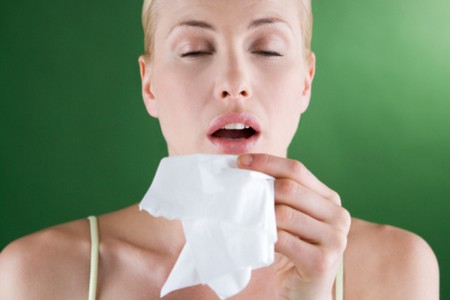Allergies occur when the body has an abnormal reaction to a substance or allergen. Allergies are caused by any number of things – foods (such as dairy products, shellfish and nuts), animal fur, dust, pollen or chemicals – and is the body’s way of fighting off what it thinks are foreign invaders. Allergies can cause asthma, eczema, hayfever, rashes or, on rare occasions, anaphylactic shock after being stung by an insect or after having eaten a particular food, such as peanuts.
When the body thinks it is being attacked by foreign invaders, it reacts by releasing antibodies. As the allergens and antibodies fight it out, this causes the release of chemicals, including histamine, which will result in the allergic symptoms. Depending on what has been eaten/inhaled/touched, this can result in an itchy rash and dry skin as in eczema; narrowing of the airways and difficulty in breathing, as in asthma; sneezing and runny nose, as in hayfever; or vomiting and diarrhoea as in food allergy. Other symptoms can include headache, wheezing, catarrh and watery eyes.

For an allergy to occur, your child will already have to have come into contact with the allergen once before. So, for instance, the first time your child stroked a cat would not have caused problems, but the second time could trigger an allergy.
Allergies tend to run in families, so if you or your partner suffer, your child is more susceptible.
What you can do
Unfortunately, cases of allergies, particularly asthma and hayfever, are on the increase. With rising pollution levels from industry and car exhaust fumes, there’s not always a lot you can do to avoid them, but you can minimize exposure to some.
- Breastfeed for as long as possible to help your child build up immunity.
- If you know your child is allergic to a certain food, cut out the offending food from their diet and check all food labels. Let their school and other parents know.
- Keep bedrooms clean, regularly vacuuming the mattress and all soft furnishings, including curtains, where dust mites – a common allergen – live. It also helps to use synthetic (non-feather) duvets and pillows and to cover mattresses, pillows and duvets with dust proof covers. Wash all bedding weekly in a hot wash (60° C).
- Contact with cleaning products (although these should be kept locked up anyway) can cause reactions. Thoroughly rinse the bath or sink after cleaning.
- If your child seems to break out in a rash after a hug from you, it could be a reaction to your perfume or deodorant.
- Ionizers release negative ions into the atmosphere to counter positive ions which can lead to headaches and irritability, and may be useful for asthmatics. They cost from about £35 from chemists, electrical or natural health stores.
Treatment
Kinesiology
This therapy is most well known for identifying allergies. It is said to take the guess-work out of finding which foods your child is sensitive to. Muscle testing is used to assess the body’s response to each food that is introduced by placing a small amount between the lips or holding it in the hand. The muscle will either stay strong or weaken if the food is having a detrimental effect. Kinesiologists see food sensitivities as a symptom, not a cause, of illness. When a child is stressed or unwell, they are more likely to develop a reaction to a food, usually one they eat most of, such as wheat or dairy products. Kinesiologists may suggest excluding the offending food and will also work on building up the immune and endocrine systems with treatment and nutrition. Once the symptoms are relieved, the body will get back to optimum health over a few months and then the food may be retested and reintroduced to the diet if there are no problems.
Homoeopathy
A homoeopath may prescribe Sulphur for an itchy rash, Euphrasia for itchy, watering eyes or Nat. mur. for a runny nose, to suit your child. A change of diet and lifestyle may also be recommended, depending on the type of allergy. In case of severe food allergy, as e.g. with nuts, which can cause anaphylactic shock and even be fatal, Apis mel. can be beneficial, as well as Sublingual Immunotherapy.
Herbal medicine
A herbalist may recommend an infusion of Elderflower, which has decongestant properties which can help to loosen phlegm and also acts as a relaxant to calm the nerves and allay any anxieties the child may be feeling about their allergy. Other herbs such as Eyebright which works as an anti-inflammatory and astringent and Plantain which has useful expectorant properties may also be advised.
Acupuncture
One study found that giving patients acupuncture before the pollen season started was successful in nearly 70 per cent of cases and in some cases the success achieved lasted for more than three years. Although acupuncturists understand the use of allergy testing so that allergens can be identified and avoided, they will want to find the underlying reason or cause for the allergy surfacing in the first place, such as what they see as a deficiency of energy in the spleen or kidney. This may be due to not sleeping, a lack of fresh fruit and vegetables or they may see it as acquiring too much static electricity from being too close to a TV set for too long.

Caution
An extreme allergic reaction, known as anaphylactic shock, when the victim suffers a sudden lowering of blood pressure, may cause them to pass out. Other symptoms include difficulty in breathing, due to airways narrowing, swelling of the tongue or throat, pain in the abdomen and diarrhoea. Immediate medical attention should be sought.
Other therapies that may be beneficial: traditional Chinese medicine, yoga, Bach Flower Remedies, osteopathy.